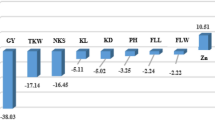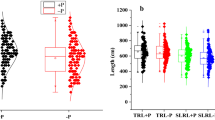Abstract
Some maize (Zea mays L.) hybrids grown in high pH soil in Nebraska suffer from severely reduced yields caused by iron (Fe) deficiency chlorosis. Hybrids which recover from early season Fe-deficiency chlorosis and yield well are termed Fe-efficient or tolerant. Most Fe-efficient gramineous species respond to Fe-deficiency stress by releasing phytosiderophores (mugineic acid and its derivatives) into the rhizosphere, thereby increasing Fe availability and uptake of the Fe3+-phytosiderophore complex via a high affinity uptake system. Field-grown Fe-efficient maize recovers from Fe-deficiency chlorosis at a stage when nodal roots have become the dominant root system. Quantifying phytosiderophore release from hydroponically grown plants has been proposed as a viable alternative to time-consuming and variable field trials and has been used successfully to delineate among Fe-efficient and Fe-inefficient lines of oat (Avena sativa L.) and wheat (Triticum aestivum L.). Our objectives were (1) to determine if phytosiderophore release differed between nodal- and primary-root systems of maize, and (2) to compare phytosiderophore release from 12 hybrids. Root exudates secreted during daily 4-h collections were analyzed for their Fe-solubilizing ability, which was equated to phytosiderophore release. Nodal root systems released significantly more phytosiderophore than primary- or complete-root systems. In early experiments, an Fe-efficient hybrid (P3279) released more phytosiderophore from nodal roots than an Fe-inefficient hybrid (P3489). Tests of an additional 10 hybrids showed that phytosiderophore release varied significantly among the cultivars but did not clearly distinguish between hybrids classified as Fe-efficient or Fe-inefficient in individual company trials. We recommend using nodal roots when studying Fe-stress response mechanisms in maize.
Similar content being viewed by others
References
Bar-Ness E, Hadar Y, Chen Y, Römheld V and Marschner H 1992 Short-term effects of rhizosphere micro-organisms on Fe uptake from microbial siderophores by maize and oat. Plant Physiol. 100, 451-456.
Bernards M L and Jolley V D 1999 Phytosiderophore release from primary or secondary roots of Fe-stressed maize. In 1999 Annual Meetings Abstracts. p 91. ASA-CSSA-SSSA, Madison WI.
Bernards M L, Jolley V D and Hubbard B C 2000 While you were sleeping: Diurnal patterns of phytosiderophore release in iron-deficient maize. In 2000 Annual Meetings Abstracts. p 288. ASA-CSSA-SSSA, Madison, WI.
Bienfait H F, Van den Briel W and Mesland-Mul N T 1985 Free space iron pools in roots: Generation and mobilization. Plant Physiol. 78, 596-600.
Cahn M D, Zobel R W and Bouldin D R 1989 Relationship between root elongation rate and diameter and duration of growth of lateral roots of maize. Plant Soil 119, 271-279.
Clark R B, Römheld V and Marschner H 1988 Iron uptake and phytosiderophore release by roots of sorghum genotypes. J. Plant Nutr. 11, 663-676.
Ellsworth J E, Jolley V D, Nuland D S and Blaylock A D 1997 Screening for resistance to iron deficiency chlorosis in dry bean using iron reduction capacity. J. Plant Nutr. 20, 1489-1502.
Ellsworth J E, Jolley V D, Nuland D S and Blaylock A D 1998 Use of hydrogen release or a combination of hydrogen release and iron reduction for selecting iron-efficient dry bean and soybean cultivars. J. Plant Nutr. 21, 2639-2651.
Hansen N C and Jolley V D 1995 Phytosiderophore release as a criterion for genotypic evaluation of iron efficiency in oat. J. Plant Nutr. 18, 455-465.
Hansen N C, Jolley V D, Berg W A, Hodges M E and Krenzer E G 1996 Phytosiderophore release related to susceptibility of wheat to iron deficiency. Crop Sci. 36, 1473-1476.
Hergert G W, Nordquist P T, Petersen J L and Skates B A 1996 Fertilizer and crop management practices for improving maize yields on high pH soils. J. Plant Nutr. 19, 1223-1233.
Hoppe D C, McCully M E and Wenzel C L 1986 The nodal roots of Zea: Their development in relation to structural features of the stem. Can. J. Bot. 64, 2524-2537.
Jolley V D and Brown J C 1989 Iron efficient and inefficient oats: I. Differences in phytosiderophore release. J. Plant Nutr. 12, 423-435.
Jolley V D and Brown J C 1991 Differential response of Fe-efficient and Fe-inefficient corn and oat to phytosiderophore released by Fe-efficient Coker 227 oat. J. Plant Nutr. 14, 45-58.
Jolley V D, Fairbanks D J, Stevens W B, Terry R E and Orf J H 1992 Root iron-reduction capacity for genotypic evaluation of iron efficiency in soybean. J. Plant Nutr. 15, 1679-1690.
Kawai S, Takagi S and Sato Y 1988 Mugineic acid-family phytosiderophores in root secretions of barley, corn, and sorghum varieties. J. Plant Nutr. 11, 6-11.
Lytle C M and Jolley V D 1991 Iron deficiency stress response of various C-3 and C-4 grain crop genotypes: Strategy II mechanisms evaluated. J. Plant Nutr. 14, 341-362.
Marschner H 1995 Mineral nutrition of higher plants. 2nd edn. Academic Press, San Diego, CA.
Marschner H, Römheld V and Kissel M 1986 Different strategies in higher plants in mobilization and uptake of iron. J. Plant Nutr. 9, 695-713.
Marschner H, Römheld V and Kissel M 1987 Localization of phytosiderophore release and of iron uptake along intact barley roots. Physiol. Plant. 71, 157-162.
Mori S, Nishizawa N, Kawai S, Sato Y and Takagi S 1987 Dynamic state of mugineic acid and analogous phytosiderophores in Fe-deficient barley. J. Plant Nutr. 10, 1003-1011.
Nordquist P T, Hergert G W, Skates B A, Compton W A and Markwell J P 1992 Phenotypic expression of different maize hybrid genotypes grown on saline-sodic soil. J. Plant Nutr. 15, 2137-2144.
Nordquist P T, Hergert G W, Skates B A and Petersen J L 1996 Genetic improvement of corn for tolerance to high pH soils. J. Plant Nutr. 19, 1309-1317.
Onyezili F N and Ross J D 1993 Iron deficiency stress responses of five graminaceous monocots. J. Plant Nutr. 16, 953-974.
Römheld V and Marschner H 1986 Evidence for a specific uptake system for iron phytosiderophores in roots of grasses. Plant Physiol. 80, 175-180.
Römheld V and Marschner H 1990 Genotypical differences among graminaceous species in release of phytosiderophores and uptake of iron phytosiderophores. Plant Soil 123, 147-153.
SAS Institute 1996 The SAS system for Windows, Release 6.12. SAS Institute, Cary, NC.
SAS Institute 1999 Selected SAS documentation for Agronomy 526: Field plot technique. 1st edn. SAS Institute, Cary, NC.
Smith C W 1995 Crop production: evolution, history, and technology. John Wiley and Sons, New York.
Takagi S 1976 Naturally occurring iron-chelating compounds in oat and rice-root washings: I. Activity measurement and preliminary characterization. Soil Sci. Plant Nutr. 22, 423-433.
Takagi S, Nomoto K and Takemoto T 1984 Physiological aspect of mugineic acid, a possible phytosiderophore of graminaceous plants. J. Plant Nutr. 7, 469-477.
Von Wirén N 1994 Iron efficiency in graminaceous plant species and the role of microbial degradation of phytosiderophores in iron acquisition. Ph.D. diss. Universität Hohenheim, Institut für Pflanzenproduktion, Stuttgart, Germany.
Weaver J E, Jean F C and Crist J W 1922 Development and activities of roots of crop plants: a study in crop ecology. Carnegie Inst. of Wash. Publ. 316. Technical Press, Washington, D.C.
Wei L C, Loeppert R H and Ocumpaugh W R 1997 Fe-deficiency stress response in Fe-deficiency resistant and susceptible subterranean clover: Importance of induced H+ release. J. Exp Bot. 48, 239-246.
Weiss M G 1943 Inheritance and physiology of efficient iron utilization in soybeans. Genetics 28, 253-268.
Williams J D, Skousen D H, Bernards M, Perry M E, Jolley V D and Morelock T E 2000 Evaluation of Strategy I response mechanisms in cowpea (Vigna unguiculata). In 2000 Annual Meetings Abstracts. p 280. ASA-CSSA-SSSA, Madison, WI.
Yehuda Z, Shenker M, Römheld V, Marschner H, Hadar Y and Chen Y 1996 The role of ligand exchange in the uptake of iron from microbial siderophores by gramineous plants. Plant Physiol. 112, 1273-1280.
Author information
Authors and Affiliations
Corresponding author
Rights and permissions
About this article
Cite this article
Bernards, M.L., Jolley, V.D., Stevens, W.B. et al. Phytosiderophore release from nodal, primary, and complete root systems in maize. Plant and Soil 241, 105–113 (2002). https://doi.org/10.1023/A:1016084023377
Issue Date:
DOI: https://doi.org/10.1023/A:1016084023377




